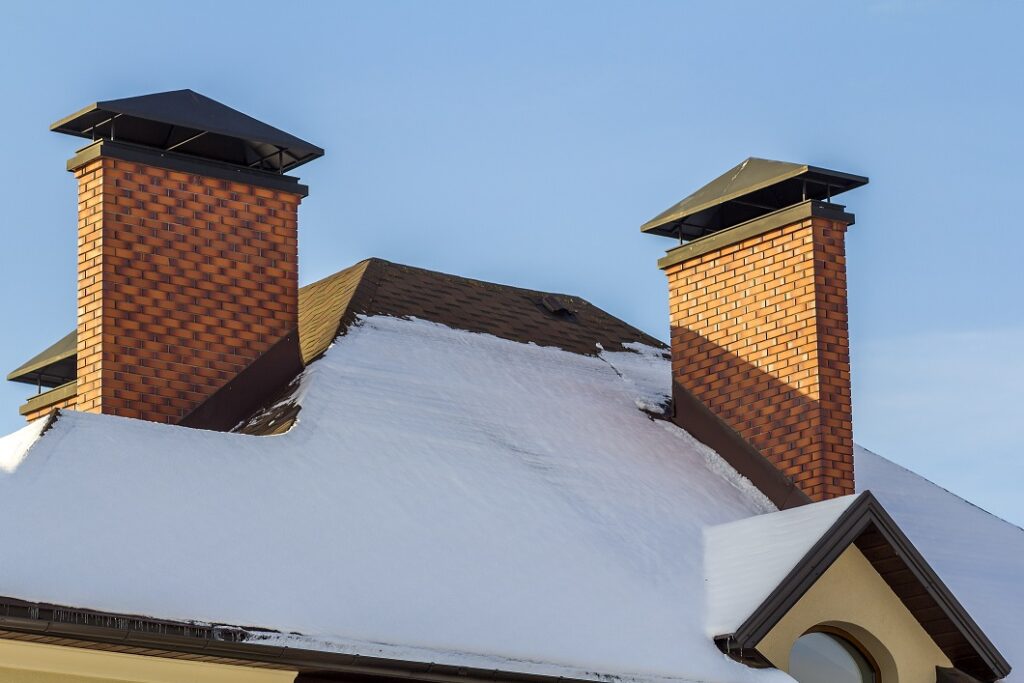 Is It Bad To Have Bats In Your Chimney?
Is It Bad To Have Bats In Your Chimney?
While bats are considered to be beneficial to the environment, having them in your chimney and home is anything but pleasant.
Typically, chimneys can be a way for bats to get in by mistake. This wildlife can accidentally enter your house through the chimney. Whatever the case, there are multiple issues and dangers associated with having bats in the chimney and you should therefore deal with the infestation as soon as possible.
Bats can cause serious annoyance and a real danger to your chimney. Many bat species tend to colonize, and the chimney is a great place for bats to build their nest. The nesting material can go up flames when a fire is burning in your fireplace and cause a chimney fire if not taken care of immediately.
When bats roost in chimneys, their urine and droppings accumulate on roof shingles and bricks. This results in a musty odor and dirty runoff when it rains.
The whole house will start to smell, making it unbearable to live in.
Bats living in the chimney also create unsightly, dark, greasy stains that look similar to those left by rodents.
If you spot a bat trapped in your chimney, you should not touch or go near it, even when it’s dead. Bats are dangerous animals as they spread numerous diseases that can be deadly to humans. Whenever bats live near humans, there is a high risk of contracting rabies from their bite. Even a dead bat may carry the disease.
In addition, bat urine and droppings can also be harmful to the health of those who live in the house. Airborne spores that develop in guano, i.e. bat feces, can transmit Histoplasmosis to people.
Can Bats Get In Through The Chimney?
Bats can quickly fly down and up the chimney. If you go outside and watch their flight direction, you may see them heading out to feed at dusk or getting back at dawn.
These pests will infest homes by slipping around metal flashing around the chimney. They have the ability to fit into very small openings and can enter the chimney through a gap as small as 3/8 of an inch.
If you have bats in your chimney chances there is likely some damage to the chimney or a missing cap in the structure. Bats tend to enter chimneys through loose mortar joints or tuck points.
The chimney is a convenient place for bats to find entry into your home. As you probably don’t have a fire burning in your fireplace 24/7, these mammals will easily access the interior of your home.
The chimney is a logical path to choose as its structure is basically a large passageway that leads from your home’s warm interior to the cold outside world. The protected shaft provides a safe haven for wildlife to build nests and a quiet place for them to shelter from the elements. However, bats roosting in the chimney is bad news for you.
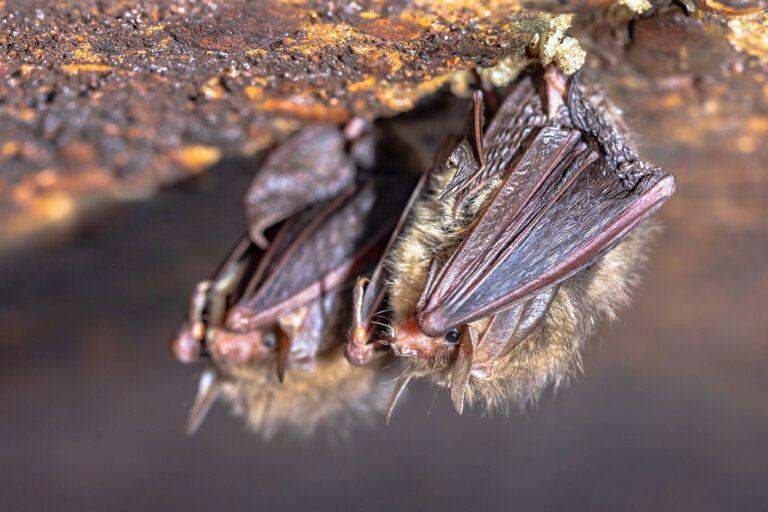
Do Bats Roost And Live In Chimneys?
Typically, bats are found living in attics and crawl spaces, but it is very common to encounter them living inside chimneys as well.
Bats love to live in the chimneys of residential and commercial buildings. Chimneys can be a great home for critters as they offer all of the roosting requirements for bat colonies. They are dark and secluded, and give enough space for them to hang upside down.
The shelter and warmth of the heat coming up from your house through the chimney makes it a very attractive nesting area.
These animals generally enter chimneys to reproduce and hibernate. Female bats particularly need a warm and safe place in which to raise their young. Therefore, if you have a maternity colony of bats living in your chimney, it can mean a long-lasting problem for your home. This wildlife has strong homing instincts and usually returns to the same roosting site to breed every season.
How To Tell If You Have Bats In Your Chimney?
There are some signs that indicate that you have bats living in your chimney.
Do an inspection to find out exactly where the bats are going in and out. They tend to choose small horizontal openings. If you do a night watch, you might observe the bat swarm flying out of areas near your chimney around dusk or dawn. This is when they are leaving as a group or are returning as a group.
Bats make distinctive sounds in the chimney, which can differentiate them from birds or other wildlife. You may hear high-pitched squeaking, cheeping, and rapid wing movements coming from inside the flue. These sounds are particularly noticeable at dusk and dawn when they are awake and moving around.
Bat droppings can be found around the inside and outside of the chimney. You might smell a strong, unusual ammonia-like odor that’s similar to a dirty litter box.
What To Do If You Have Bats In Your Chimney?
If there are bats infesting your chimney, various methods can be helpful.
First of all, it is important to block their entry by sealing all entrances except one and then installing exclusion tubes. This is a device that is a one-way exit so that the bats can fly out but can’t get back in.
Placing wire mesh screens over a chimney deters bats from roosting, however, make sure you don’t accidentally trap any animal inside.
Chimney caps are another easy method to keep bats and other forms of wildlife from gaining access to your home. Galvanized steel is the best option for sealing holes around chimneys.
Lastly, remember to never attempt to remove a bat from your chimney yourself. Always seek the help of a licensed professional.
If you believe you have unwanted guests in your chimney, don’t panic. Bats in chimneys do not have to be a headache.
At Westchester Wildlife, our experts understand the risks associated with bat removal and know how to safely, humanely, and legally remove these pests from chimneys. Call us today to schedule a consultation or to learn more about our bat removal services in Westchester, Dutchess, and Putnam Counties, NY, or in Fairfield County, CT.
Two brown hibernating bats
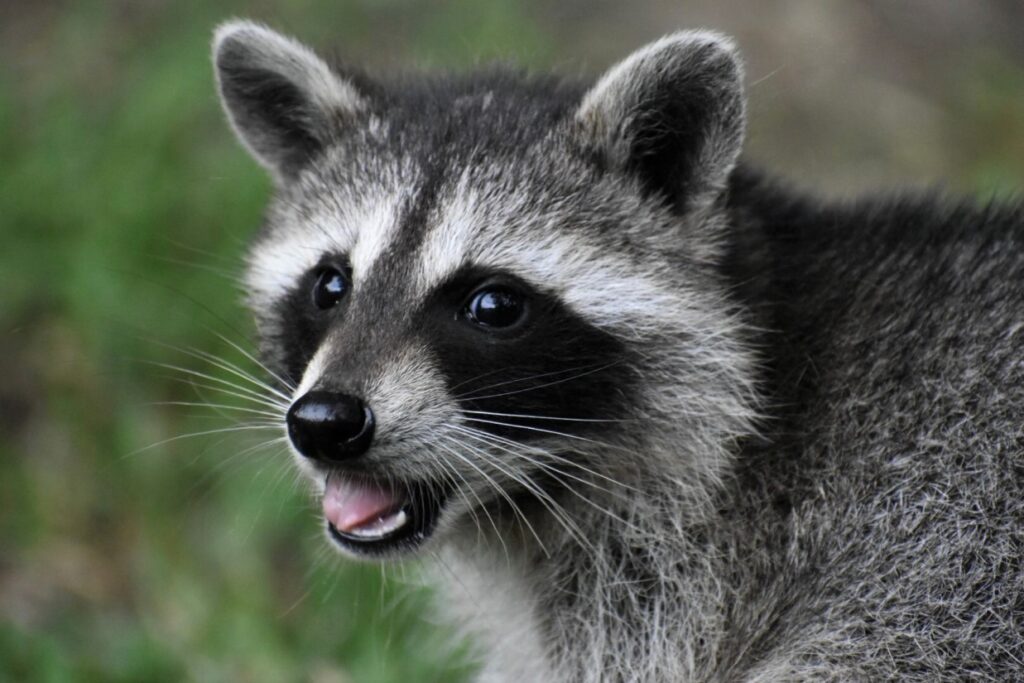 A Raccoon Won’t Go In Trap? Here’s What To Do
A Raccoon Won’t Go In Trap? Here’s What To Do
Raccoons can be a true nuisance when they invade your property. If you spot a raccoon, or several of them, they may be there because they intend to forage in your garbage cans and cause destruction all over.
Keep in mind that raccoons are intelligent and resourceful animals. They can be also dangerous for people and pets as they tend to carry various diseases such as rabies.
Keep reading for more information on how you can outsmart a raccoon, trap it, and get rid of it from your property. But before you indulge in trapping these animals, check your state’s law if it is legal to trap a raccoon by yourself.
Can A Raccoon Outsmart A Trap?
It can be a real challenge to trap a smart raccoon. This wildlife is not stupid and will often outsmart and escape the trap. The raccoon may be already familiar with the trap and know it better. It might have been caught in traps before and will learn from that experience. Next time, the raccoon you’re after will avoid your trap and all traps altogether later on.
So don’t be surprised if the animal outsmarts your trap, shows up, and raids the trap without getting caught.
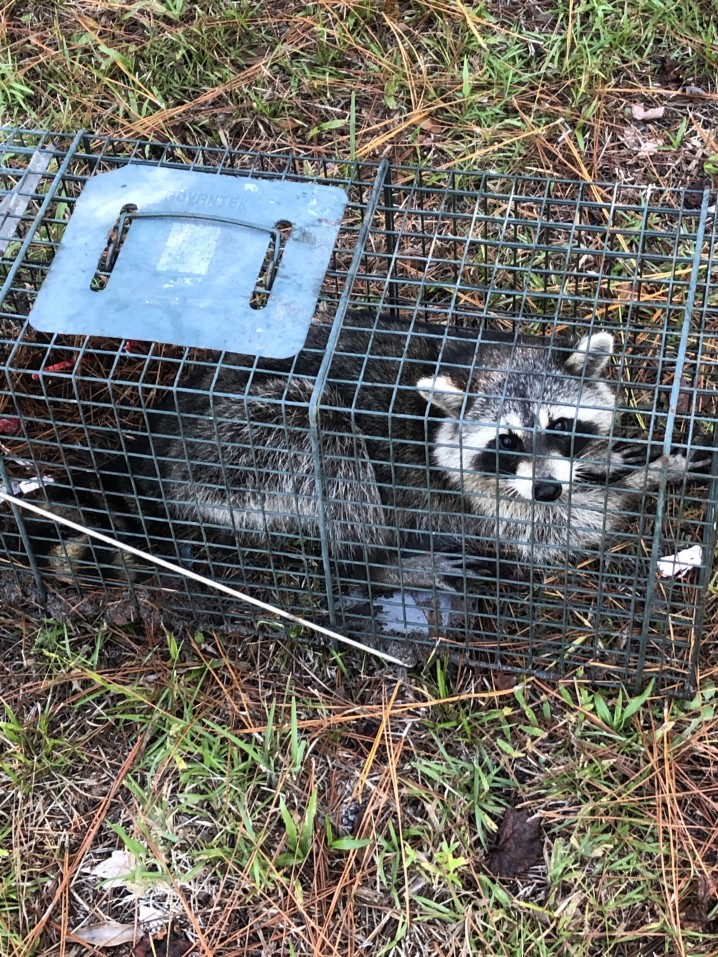
How Do You Trap A Smart Raccoon?
Having said that, there are ways to trap a smart raccoon.
First, you must be aware that raccoons are nocturnal in nature, which means they are mostly active at night. They usually sleep during the day and stay up all night foraging for food. As soon as the sun sets in, these animals leave their dens and head straight for the nearest food source.
It’s important to place your trap far away from any human or pet activity. So put the trap along the edge of your yard, beside physical boundaries such as the fence or dense vegetation.
Then just wait for the raccoon to come out of its hiding.
Know that if this is a smart raccoon, it won’t go into the trap immediately after placement. It will perceive the trap as a threat and can also sense if the trap is brand new and hasn’t been used for any other animal before. It’s better to wait a bit and give the animal some time to get familiar with the trap, before setting it right away.
It can also happen that the raccoon keeps stealing bait from the trap. In this case, a better quality trap that secures the bait will be needed. These clever animals can easily detect a trap and will quickly snatch bait from the trap.
Also, it’s worth mentioning that despite its big body, a raccoon can squeeze through an opening that’s only 4 inches wide.
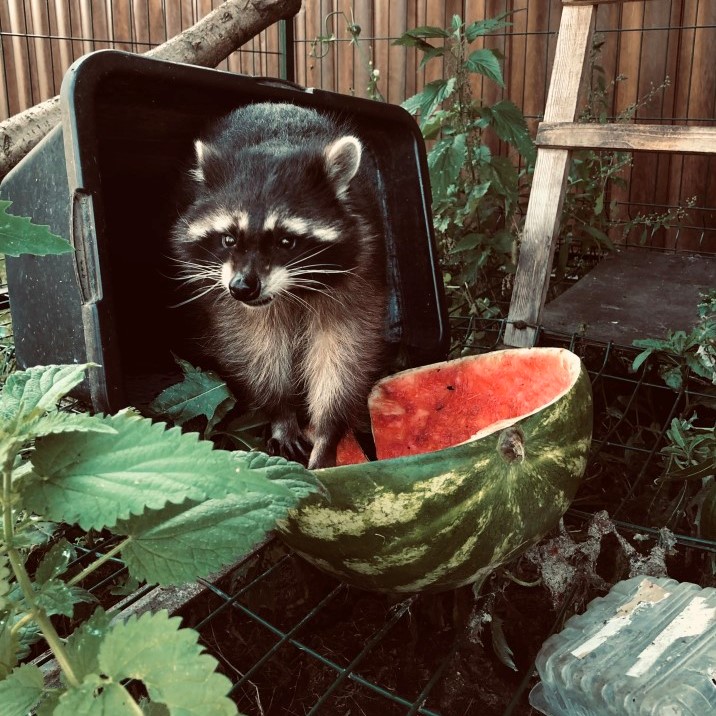
What Is Good Bait For Trapping Raccoons?
There are some foods that are irresistible to raccoons and you may use those as good bait to lure a raccoon into your trap.
Fatty meats and sweet foods are some of the best baits you can place in a live trap when you want to catch a nuisance raccoon. Bacon attracts these animals really well. Fresh ripe fruit, candy, marshmallows, molasses, strawberry sugar wafers, as well as sugar or honey-coated vegetables will definitely catch the raccoon’s attention.
Some other popular baits that have been very effective on raccoons include canned cat food that is wet and smelly.
Another bait option is food that is the preferred raccoon diet, such as fish, snails, frogs, crayfish, and clams.
Canned tuna, sardines, or salmon packed in oil are also good bait for trapping raccoons.
In addition, whole eggs, white bread, chicken meat, sweet corn on the cob, and nuts make great bait for raccoons.
These are the foods that raccoons like to eat the most, but in fairness, they will eat nearly anything else. After all, they are known for digging through people’s bins in search of their next meal.
Place your chosen food items behind the pan of the cage trap. Then, sprinkle some of the sweet juice around so that it leads the animal straight to your trap.
After you set your live trap, you must remember to check it often, at least once a day. This is to make sure the animal that’s caught doesn’t die inside the trap. It can take anywhere from a couple of hours up to a few days to catch a raccoon that’s smart and won’t go in the trap. Under no circumstances leave a raccoon trapped for an extended period of time such as longer than 24 hours.
If any other non-target animal has accidentally been captured, you should release it immediately. Once you have caught a raccoon in your trap, check with your local authorities to find out the correct way to relocate the animal.
Also, do not handle a trapped raccoon with your bare hands. The wild animal can be dangerous to humans. You are going to be exposed to the diseases they carry, they may attack you or run away.
The best option would be to call a wildlife removal expert to handle your case.
If you are experiencing raccoon problems in your yard, contact our Westchester Wildlife team in Westchester, Dutchess, or Putnam County, NY, or in Fairfield County, CT. We are your local wildlife control specialists that handle all types of nuisance wildlife. So if you have raccoons invading your property, call us to learn more about your trapping and removal options.
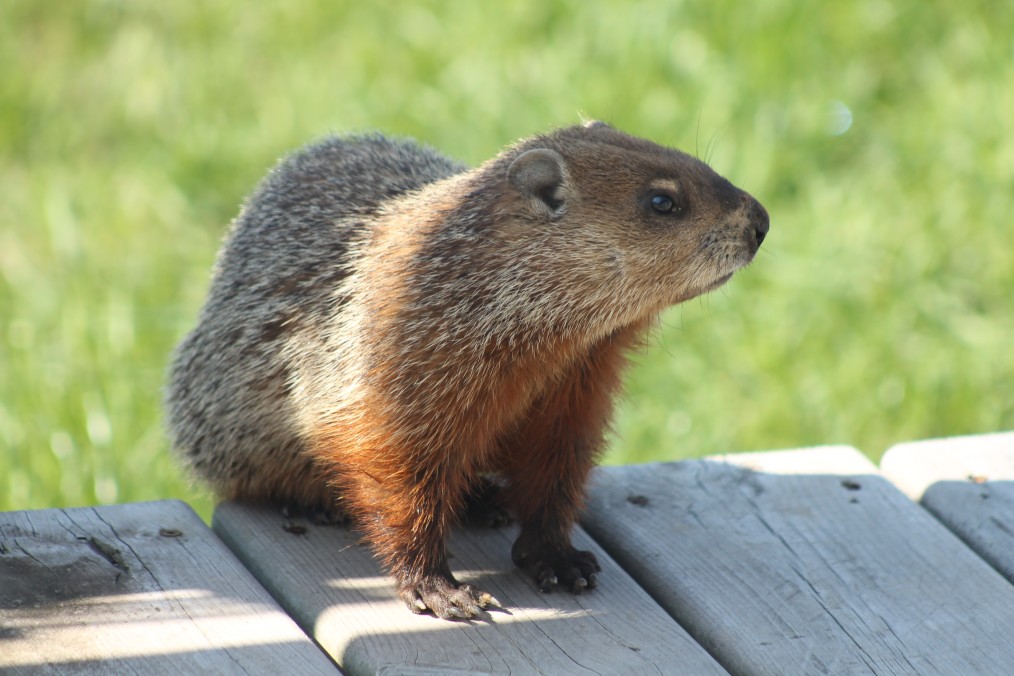 What Does It Mean When You See A Groundhog In The Summer?
What Does It Mean When You See A Groundhog In The Summer?
The groundhog is known for predicting the weather in early February, but it can make an appearance in your yard on a bright summer day as well.
A groundhog, also known as a woodchuck, is the largest member of the squirrel family and can be a nuisance pest when it invades your garden beds and yard. Even though groundhogs favor forested areas, they are very adaptable and will keep coming back to places where they are able to find plenty of food and a suitable shelter.
Groundhogs will readily come into your yard searching for food and a safe place to burrow. Therefore, you should take some steps to make your yard less attractive to this wildlife and to reduce the damage, for example, harvesting your garden crops as soon as possible to limit their food sources.
Read on to find out the exact reasons why you might see groundhogs on your property in the summer.
Do Groundhogs Come Out In The Summer?
Groundhogs start being active as soon as the nice spring weather sets in. They like warm, bright, and sunny weather, but dislike rain. This is because they can see clearly and inspect their surroundings better on a sunny day. Also, sunshine and warmth are suitable for them as they don’t need to adjust their body temperature anymore.
However, extreme summer heat doesn’t suit them either, and they will struggle. In such hot weather, they have to find ways to survive. They will therefore have to cool off in the water or remain hidden most of the time in their cool dens.
Groundhogs sleep in their burrows during the summer. In fact, they build a section in their den that looks like their summer house from where they can emerge more easily.
They will only go outside to find food when it’s not too hot, that is, during the very early morning and late evening hours. In extremely hot temperatures, they will be forced to stay in their burrows for the vast majority of the day and only come out for up to two hours a day. When not foraging for food in the summertime, the groundhog can often be observed sprawled out outside, grooming itself, taking naps, and enjoying the warm sunshine in the afternoon.
During the summer, usually in August and early September, groundhogs will eat a lot as they need to bulk up their fat stores in anticipation of winter and hibernation from mid-October. During this period, there will be an uptick in groundhog occurrences and indicators of their activity, such as bite marks and hollowed-out crops. The animal will consume up to a pound of food per sitting.
Another reason why groundhogs are frequently seen in summer is their breeding schedule. Females have babies after hibernation, from March to the end of April and even May. The young have enough time to mature through the summer so that they can build their own burrows in preparation for winter hibernation.
If you want to learn more about what exactly attracts groundhogs to your yard and what damage they can cause, check out our blog post.
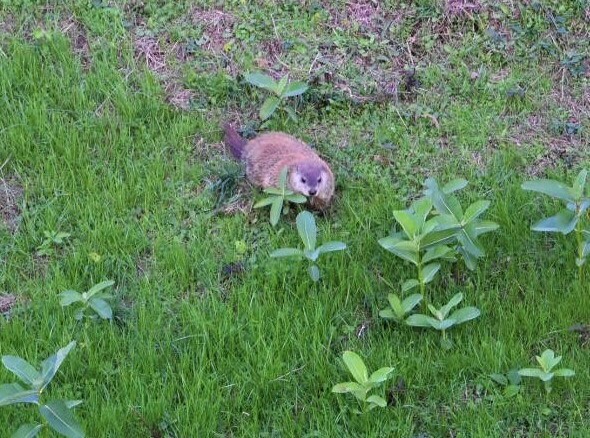
Typically, groundhogs change their habitat according to the season. In the summertime, they are most prevalent as they prefer to live in locations where food is available, such as in open pastures and agricultural fields, suburban backyards, brush, and areas close to vegetable gardens. In the colder months of the year, they choose open woodlands and forested areas to hibernate.
To deter groundhogs from invading your yard in the summer, make it less appealing for them to dig through. These animals tend to burrow in drier soil, unlike many other ground-burrowing rodents. Therefore, keep the soil in your yard as moderately damp as possible. Instead of having your sprinklers on the whole time to cover the entire yard, water only the areas where groundhogs might burrow like dense shrubbery and bushes.
Is It Normal To See A Groundhog During The Day?
These animals are diurnal so it is normal to see a groundhog in your yard during the day. They are daytime foragers and are almost never seen outside of their den after sunset.
During the summer months, the groundhog will only search for food at dawn and dusk. So you will notice that your garden crops are receiving the most damage at this time. Also, check your fruit trees for any marks as these pests might gnaw and claw at them.
From spring to fall, groundhogs are most active during the day and sleep at night, so they don’t usually come out after dark. However, it might occasionally happen that you spot a groundhog roaming your garden at night.
What Do Groundhogs Eat In The Summer?
Groundhogs tend to eat twice a day in the summertime, with each feeding session lasting up to 2 hours.
They are herbivorous and will find almost all vegetable matter in your yard irresistible. During the summer, groundhogs will eat vegetables, such as corn, carrots, lettuce, celery, peas, red tomatoes, and green beans. They also enjoy a wide variety of sweet fruits, such as berries, cherries, apples, and pears. Alfalfa and clovers are some of their favorite foods.
If there aren’t any vegetables available, groundhogs will settle for grubs, insects, and snails, as well as twigs, bark, weeds, dandelion greens, grasses, herbs, and flowers.
Groundhogs live by seasonal behaviors, so mid-to-late summer is the best time to exclude and eliminate them from your property. As they are active during the day when they are often seen coming in and out of their dens, it is a good time to close their burrows by blocking their easy entry and exit points so that they can move somewhere else.
Groundhog removal is not an easy job, and you will also need a nuisance wildlife control permit to relocate the animal once it’s trapped. Therefore, if you’re having a groundhog problem in your yard, you should call in a wildlife control professional for help.
If you live in Westchester, Dutchess, or Putnam County, NY, or in Fairfield County, CT, and were searching online for groundhog removal services, you’ve found your answer! Contact our experienced team at Westchester Wildlife today so that we can effectively trap and get rid of the groundhog from your yard.
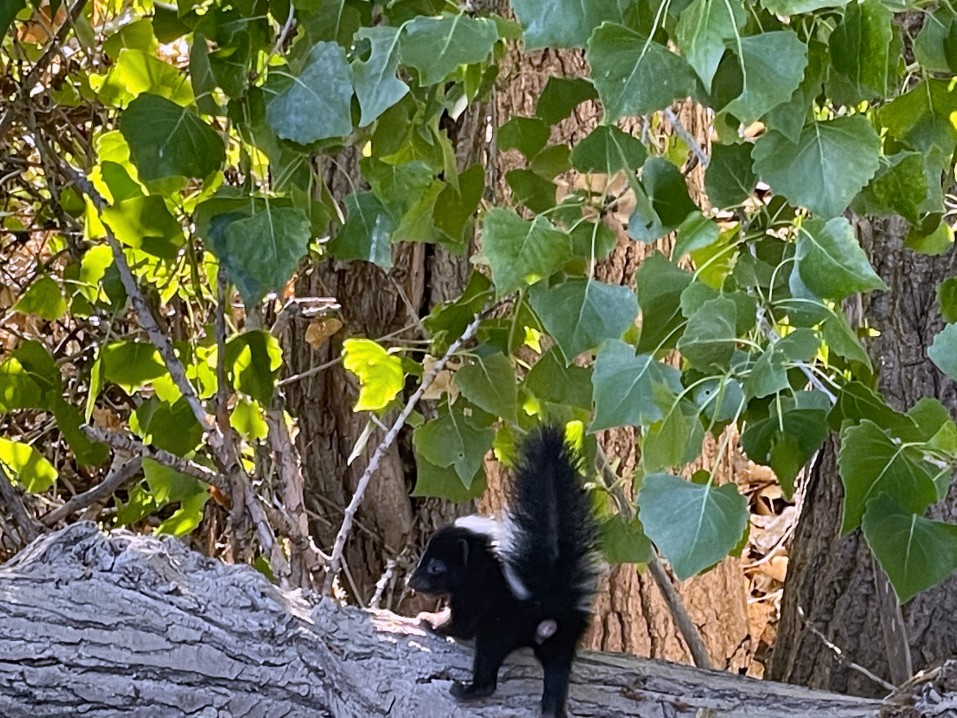 Can Skunks Climb?
Can Skunks Climb?
There are some problems that can make skunks difficult to deal with. The main issue is the odorous musk they can spray when they feel threatened. But you might also be worried that a skunk may climb a fence, tree, wall, or roof, and enter your property.
Skunk’s cat-like body might fool us to think that the animal is proficient at climbing. But in general, skunks cannot climb and jump the same way that cats do, which doesn’t mean they cannot climb at all.
Besides, skunks overall are considered to be one of the poorest climbers among such animals as raccoons, opossums, or squirrels, and they will rarely go up a tree. Their bodies are quite heavy so they are not natural climbers and will take any other alternative to climb a structure. Although they will do so in search of food, or to flee from a predator or other threat.
However, the spotted skunks are lighter in weight than other skunk species and can climb anything if they need to.
On the other hand, the striped skunks are not very good climbers and are more adept at digging than climbing. They are heavier than the spotted skunks and can climb, for example, a wire fence, but may find it difficult because of their long nails.
There is still a lot to learn about skunks and their ability to climb, though. Below, we go into more detail to give you an idea of whether you should worry about skunks climbing onto your property, so keep reading.
Can A Skunk Climb A Tree, Fence, Roof, Wall, Window, Ladder, Or Chicken Wire?
Skunk’s claws are exceptionally sharp, powerful, and long, therefore, these animals are able to dig their way into just about any type of material if they decide to climb. It doesn’t matter whether you have a wooden, chain-link, or some other fence type, a skunk is absolutely able to climb these structures with ease.
Skunks come in many sizes and shapes, and some of them are more adept climbers than others. Many skunk species struggle to climb up fences, but one species, the spotted skunk, is particularly great at fence climbing.
Spotted skunks are known as excellent climbers. As they have smaller nails, they are able to climb trees with ease and can also come head down from the tree. It will even walk along a tree branch that reaches a fence. The spotted skunk can also choose to climb fences willingly and is skillful at climbing any fence, be it wooden or solid metal.
These skunks will readily climb the fence to enter your yard, after which they might hunt small farm animals or your outdoor pet during the night.
Although the striped skunk is also able to climb up fences, boards, and wire mesh, it rarely climbs trees as it is quite a terrible climber. Its long claws are a definite disadvantage for climbing. The animal probably won’t choose to climb anything unless it really feels threatened.
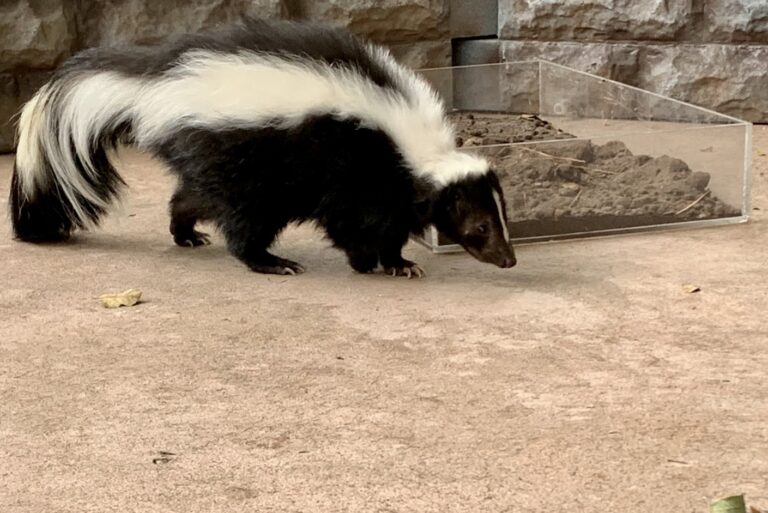
If skunks cannot burrow underground to enter your yard, they will choose to climb up trees to skip fences. As most skunk species are not good climbers, they’re not very likely to get into your attic by climbing on the roof and seek shelter in your home. But occasionally it can happen, especially if it is the spotted skunk. It can climb a fence and use tree branches to enter the roof and attic.
Skunks will climb whenever there’s the need to do so, and sometimes they can do it very well. They are also capable of climbing up the ladder, in and out of the window, and a short brick wall in your house.
However, the more common striped skunk, once it happens to fall down, for example in the window, it has a hard time climbing back out on its own.
Skunks can also climb chicken wire. But they are much more likely to chew through the chicken wire, using their claws and sharp teeth with which they’ll take apart the rather thin metal.
How High Can Skunks Climb?
How high a skunk can climb depends on the species.
Spotted skunks are excellent climbers, and therefore find it easy to climb tall fences and walls, or large trees. They can climb fences that are as high as 6 feet. Therefore, making the fences on your property tall enough is the best strategy to prevent this wildlife from climbing them.
However, the striped skunks, being poor climbers, will struggle to climb over even a 1.5-feet structure.
Also, the type of surface will also affect how high the animal could climb.
Need a skunk removal service at your location? If you worry about getting sprayed and don’t want to handle the animal yourself, hiring a professional to safely, effectively, and humanely trap and eliminate the skunk is your best option.
So contact Westchester Wildlife today as our experienced and highly qualified exterminators provide skunk trapping and removal services in Westchester, Dutchess, and Putnam Counties, NY, as well as in Fairfield County, CT.
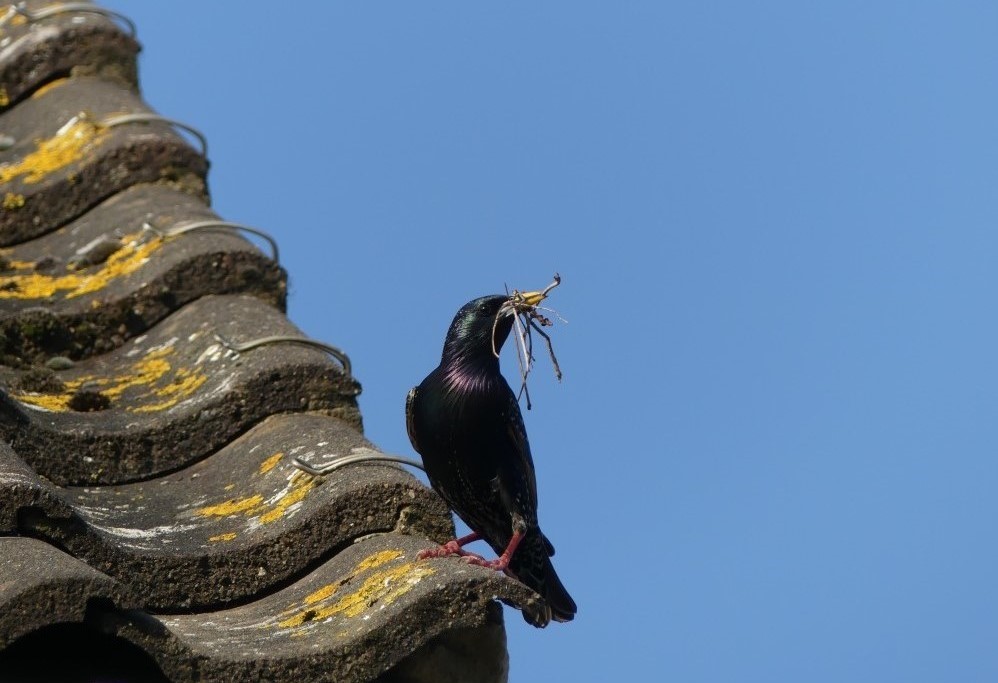 Do Starlings Nest In Vents?
Do Starlings Nest In Vents?
Starlings are a non-native bird species introduced to the US from Europe in the late 19th century. These birds are a nuisance everywhere, they reproduce and invade urban areas very rapidly.
As with any other birds, starlings nesting in vents are a very common problem, particularly during the spring when the birds start the nesting process. Most starlings will then seek the seclusion and dryness of vents in order to find a suitable place to build nests.
Research has shown that starlings are cavity nesters, which means they tend to construct their nests inside holes and crevices. This explains why they favor various vents and ducts for building nests and caring for their young.
Starling nests in vents can cause serious problems for homeowners. Keep reading to learn more about starlings nesting in vents and how to protect your home from the infestation.
Can Starlings Nest In Vents?
Starlings are very invasive birds, they can nest about anywhere, including the vents. Their nests tend to be quite large in size, and are a loosely woven mass made out of hay, grass, twigs, bark, and trash.
They like to build their nests in warm and secluded areas, which usually leads them to ductwork and exhaust vents. One of their favorite places is wall vents.
Starlings also love to nest in nice, cozy dryer vents. They are drawn to dryer vents because of their high location, as these vents are mostly some distance from the ground and therefore far from their predators.
But there are also other vents in the house where these birds might live, i.e. bathroom fan vents, oven and stove exhaust vents, microwave vents, roof vents, gable vents, or heater and furnace vents.
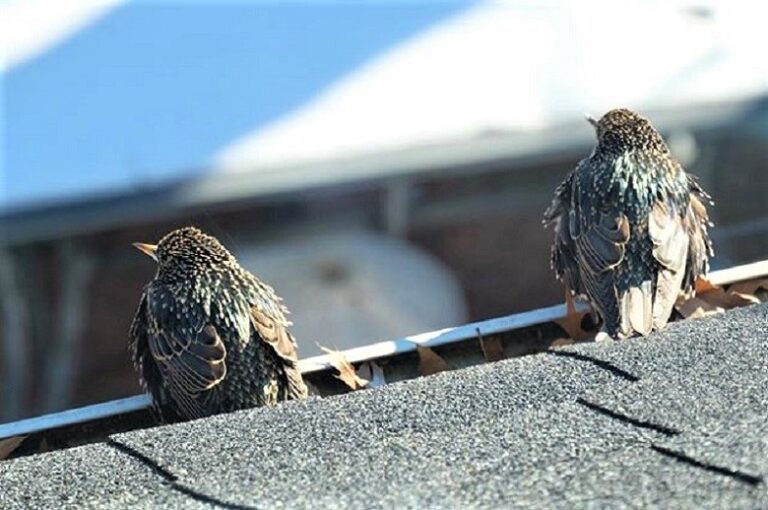
Why And How Do Starlings Get Into The Vents?
Starlings are very clever and agile creatures and know very well how to select a site to nest. Even though the vents have flaps, they are able to fly in and set up their nests in the ductwork.
Until a few years ago, starlings used to nest only in vents from which the flaps had been removed. However, these days they have figured out how to lift the vent flaps to get inside. They will fly at full speed towards the vent, then lift the flap with their beak and vanish inside without even slowing down.
Apart from the flaps, these birds can tactfully use their beaks to breach dryer vents and exhaust vents, and will also easily take advantage of broken attic vents.
The vents in the house walls are common entry points for starlings. But they can also enter inside your house through a wide variety of vents mounted on the roof, such as a ridge vent, static vent, and powered fan vent.
What Damage Do Starlings In A Vent Cause?
Starlings in a vent are especially destructive whenever they get access to your home and can cause some serious damage to your house and disrupt your well-being.
● FIRE
Once in the vent, a starling will stuff the ductwork full of combustible nest materials that restrict airflow. This can create a dangerous situation as the dry grass, twigs, and leaves can quickly catch fire.
Also, the lint build-up in the exhaust duct or dryer can block the airflow and cause overheating of the appliances, which might result in a fire.
Therefore, the issue must be dealt with as soon as possible. Keeping the vents clean and clear of any debris can save your house from a tragedy.
● APPLIANCE MALFUNCTION
If you find a nest or nesting materials that are clogging the dryer vent, it needs to be thoroughly cleaned to remove any obstructions to airflow. This is because the blockage of the dryer hose can cause overheating of the appliance. And even a partial blockage might cause the dryer to not operate properly. This can cause damage to the appliance and ultimately constitute a potential fire hazard.
So, in the case of a clogged dryer or oven vent, it is much more than just getting rid of the obstacle. It’s vital to ensure that there is a proper flow of air for the appliance to run efficiently.
Moreover, bird activity in the dryer vent can also lead to rupture of the exhaust line, which causes the dryer to ventilate into a wall or ceiling. As a result, your house will be damaged by unseen moisture.
● ODOR
If the birds got pushed or pulled into the dryer hose, you could have a foul odor to deal with.
A damaged or clogged duct in a bathroom vent will cause air contamination, meaning the air from the birds will circulate around your home. With the build-up of nesting materials, bird droppings, rotten eggs, and dead young, warm temperatures will intensify the odor. Eventually, the unpleasant smell will permeate your living areas. When you turn the exhaust fan on, the clogged line will force the air back into your house.
● HEALTH HAZARD
Starlings carry many diseases and parasites like bird mites. The parasites accumulate in the vents as the young birds are born. Eventually, those thousands of mites migrate away from empty nests or dead birds and end up inside your home. This will lead to sanitation issues, putting your family and pets at risk.
In addition, bird droppings contain a lot of pathogens and bacteria, such as E. coli and salmonella. These can have various negative effects on human health. Also, spores in bird droppings can cause an even greater health risk if inhaled.
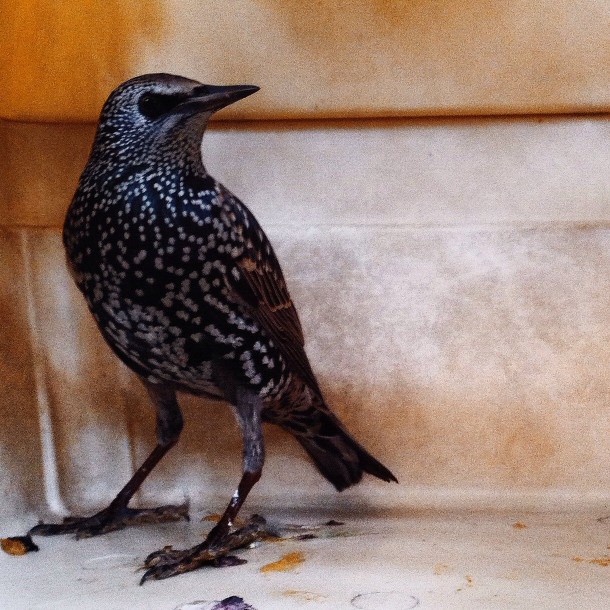
How Do You Protect Your Vents From Starlings?
As prevention is key, it’s always recommended to employ appropriate methods to keep starlings out of the vents before they start building their nest.
To prevent starlings from building nests in your vents, you should:
– Install netting, ready-made screens, guards, or long pieces of wire with a hook on the end over the vent openings.
– Install vent covers that are made of metal instead of plastic, as they will last longer in adverse weather conditions.
– Install a solid galvanized mesh on the vents. This will keep the starlings out and ensure the vents continue to operate.
Removal of starlings and their nests is a dirty, unsafe, and difficult job, therefore, it’s best to call a professional to have this service done for you.
If you need help eliminating starlings and nest material from the vents, contact our experienced team at Westchester Wildlife. We will safely get rid of the starling infestation in your home and help prevent future problems from occurring.
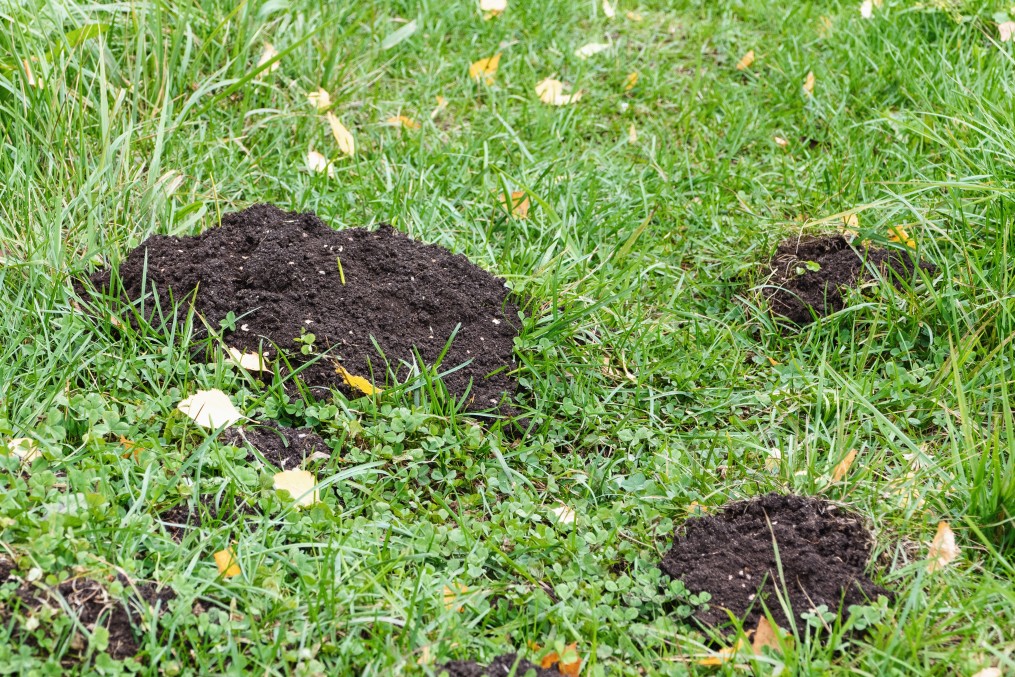 Will Moles Ever Leave Your Yard On Their Own?
Will Moles Ever Leave Your Yard On Their Own?
Moles are a common pest found in yards across the country. These small creatures can be a nuisance as they tend to tunnel through lawns and gardens, causing collateral damage.
Moles are active all year round, so it is important to understand how to deal with them if they become a problem in your yard, at some point. Keep reading to find out whether they eventually leave on their own, or you should intervene.
Are Moles Active Year Round?
Moles are active year-round and can be a nuisance any time of the year. They often build tunnels in lawns, eat the roots of plants and cause other damage in the process.
In addition, moles can create problems when the tunnels they dig in the lawn collapse, which may lead to injuring people or pets.
What Makes Moles Leave Your Yard?
There are many factors that can make moles leave your yard on their own.
One is the presence of predators, such as owls or hawks.
Moles may also leave in search of food. Thus, if they cannot find enough food in your yard, they’ll move elsewhere as they will be desperate to find more food to survive.
They may also leave if the ground becomes too wet or there is too much competition for space.
What Do Moles Eat On Your Lawn?
Moles are carnivores and primarily eat grubs, earthworms, beetles, larvae, soil insects, and other small invertebrates. Some moles can eat even 100 percent of their body weight in insects during the day, so if your lawn is not abundant in their food source, they’ll leave.
Occasionally, moles eat fallen seeds or nuts and small birds. Even though they don’t eat roots, grass, or any other plants, their tunnels will destroy the root system of nearby grass, plants, and crops, causing them to die.
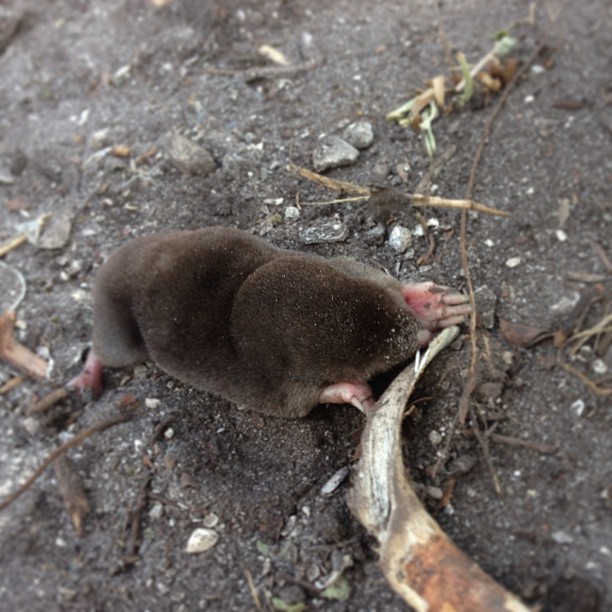
What Kind Of Destruction Do Moles Cause In Your Yard?
Moles can be detrimental to lawns and gardens as they can cause all kinds of destruction. The damages include:
Tunnels: Moles dig tunnels as they move around the area, which can be dangerous if they collapse. Their elaborate burrows can also damage ornamental plants, turf, and mowing equipment, which will often require costly replacement.
Plant Roots: Moles destroy the roots of plants, which will damage or kill the plants. This often leaves ugly brown patches on lawns. So if you have a lot of moles in your yard, you may start to see thinning patches of grass.
Lawn Sod: Moles can also destroy the sod that covers your lawn. This can be damaging and lead to areas where the soil is visible.
That means moles can also be a problem for homeowners who have just had their lawns sodded, replaced, or repaired. Irreplaceable damage to a new sod installation can occur when the animal tunnels underneath it. This will prevent the fresh sod from rooting properly and the grass will wither in a line-like pattern.
Lawn Appearance: Moles can also create mounds in lawns as they dig their tunnels. If moles are present in your yard, you may notice that the mounds are formed in a particular pattern. Their piles of soil and raised trails not only look unsightly, but are a real nuisance.
When Will Moles Go Away On Their Own, If Ever?
Unfortunately, there is no definitive answer to this question. Some moles may leave your yard on their own, while others may not. It all depends on the factors mentioned above.
Seeing all the damage the moles have caused in your yard, you may want to get rid of them as soon as possible. If moles are causing problems in your yard, there are several things you can do to remove them or make them leave your yard sooner. This may include using live traps or repellents to make your yard less attractive to them.
On the other hand, there are some advantages to having moles in your yard. Moles are beneficial creatures and play an important role in the environment. They help to aerate the soil and distribute nutrients. They also help control insect populations. While moles can be a nuisance, it is best to live with them if possible rather than remove them altogether.
They signify a healthy yard, so if you don’t have any moles in your yard, it may indicate that something is wrong with the soil or that the environment is not suitable for moles.
If moles are causing a lot of damage in your yard, you may want to consider hiring a professional to help get them to leave soon. Several methods can be used to eliminate them, however, it is important to remember that moles are beneficial and should only be removed if they are causing serious damage.
Contact Westchester Wildlife for more information on how to deal with these pests or to make an appointment. Our technicians are licensed, insured, and have real-life experience removing moles, using humane methods. We are your local pest and wildlife control company, serving Westchester, Dutchess, Putnam Counties in NY, or Fairfield County in CT.
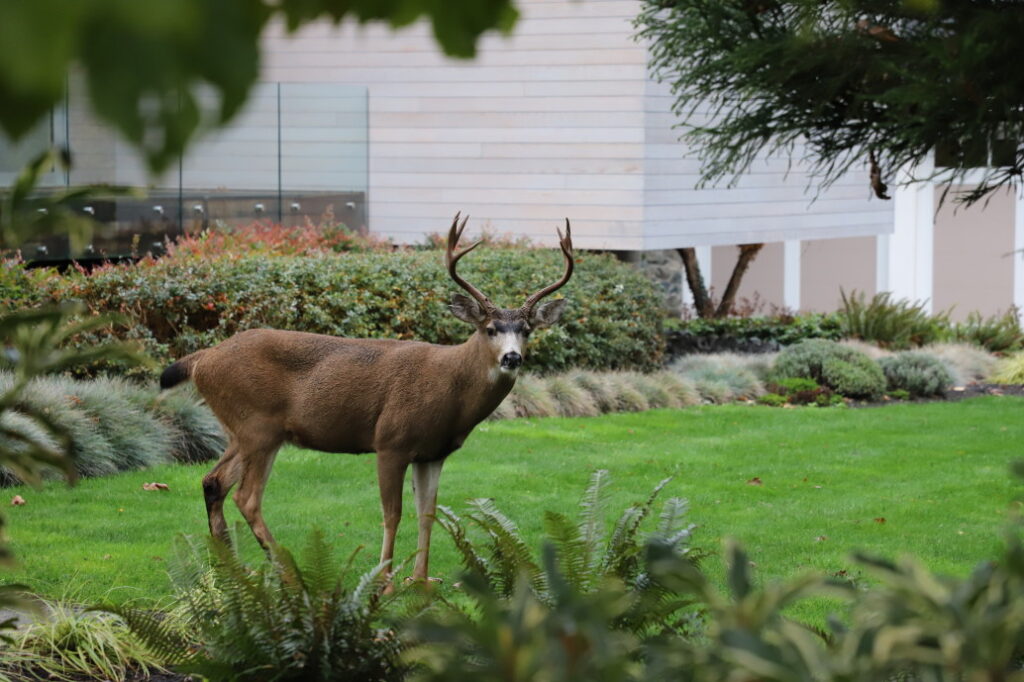 Are Deer A Nuisance To Your Yard?
Are Deer A Nuisance To Your Yard?
Homeowners and gardeners find deer a challenge and see them as a problem when this wildlife invades their property. With less and less of their natural habitat of dense forests, they are forced to look for meals in city yards.
These beautiful creatures are often considered nuisance and destructive animals. This is because they feed on landscape plants and trees, and crops in gardens, which causes a lot of damage, especially if there is a family of deer that found itself in the yard. During the winter months, cold temperatures and deep snow make deer look for food in various places, such as your yard. Also, since deer are animals of habit, they can often return to the same territory. Thus, you should be worried if you see deer in your yard.
In addition, even though deer are usually not aggressive when not provoked or frightened, they can still attack humans when they sense that they or their babies are in danger.
But deer can pose a threat in a different way as they spread disease. There is an indirect risk of attracting deer ticks to your yard, if you happen to see deer a lot. As a result, people can catch Lyme disease from deer ticks.
What Attracts Deer To Your Yard?
If you happen to have a pond, swimming pool, or any kind of water source on your property, deer may stop by and drink the water whenever it is available. In winter, they might eat snow as well or rummage in the snow to expose edible grass to eat.
However, the biggest attraction for deer is the food that is available in your yard. Deer can feed on all sorts of vegetation and crops that are commonly found in yards, ranging from lawn grass, hay, ornamental flowers, tree bark, up to vegetables and fruit.
They are herbivorous animals that spend a lot of their time browsing and foraging. To avoid predators, deer are mainly active at night when searching for food. This is when they will do most of the damage to your property.
You’ll often find deer grazing on grasses, especially if you live in a suburban area. They will eat grass, however, it is not their favorite or nutritionally essential food. They prefer to consume grass that is green, young, and succulent. Many gardeners agree that deer seem to show a preference for plants that have been fertilized. Deer are also known to dig up a lawn in search of grubs, which they like to eat in the fall.
Deer consume mainly weeds, broadleaf plants, leaves, twigs, tips of trees and woody shrubs, and shoots of woody plants or vines. Also, if you have flowers and flowering plants growing in your garden, these will definitely attract deer. They prefer daylilies, English ivy, brambles, fireweed, American mountain ash, dandelion, sweet lupin, hostas, campion, redleg, chicory, hoary cinquefoil, red clover, ribwort plantain, yarrow, and occasionally the thorny canes of rose bushes. Deer will devour on the buds, blooms, and foliage.
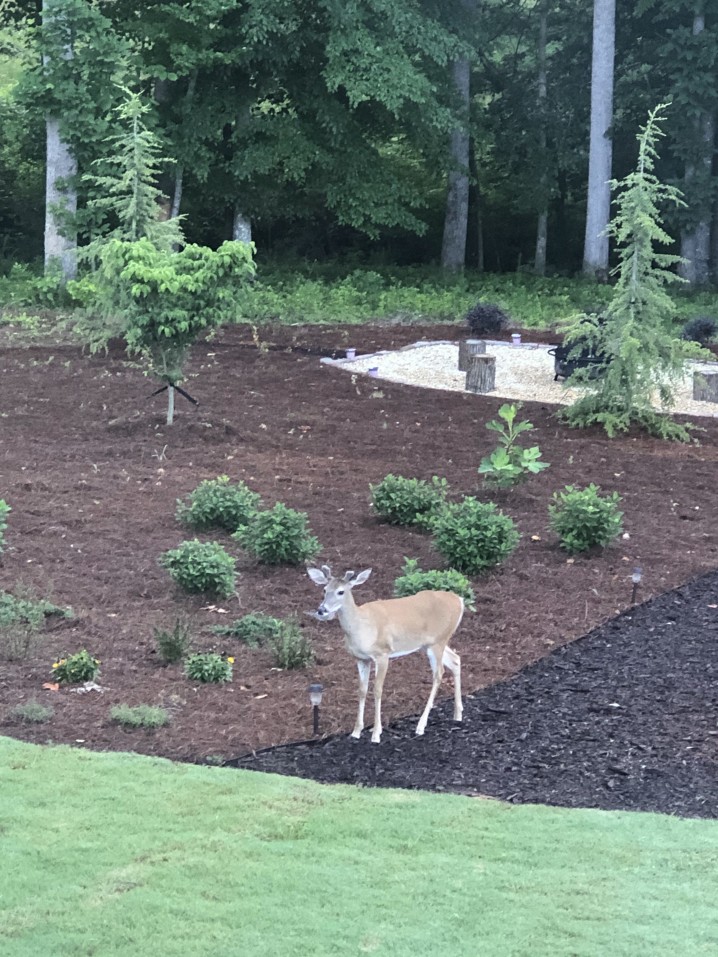
Fruits that are appealing to these animals and satisfy their appetites include apples, strawberries, blackberries, blueberries, and persimmons.
When food is scarce, deer will also not despise many vegetables and will eat just about anything like hot peppers or prickly-stemmed okra. The vegetables that deer choose to consume include certain high-protein crops such as beans, peas, cabbage, broccoli, kale, lettuce, turnips, cauliflower, soybeans, alfalfa, sorghum, corn, and Brussels sprouts. Carrots are among their favorite vegetables, deer will enjoy digging up the carrots and eating them.
Deer are especially fond of the narrow-leaf evergreens, especially fir and arborvitae trees. They love the tender tips of young trees. Also, they like the nutritious nuts that come from pecans, chestnuts, hickory, acorns and beechnut acorns.
Finally, deer cause damage not only through consuming the various plants and crops. Deer will stomp all over the garden and lawn, kick around plants, and compact the soil.
What Damage Do Deer Cause To Trees?
Deer will eat the bark of young trees, as well as any buds, twigs, and acorns they can reach. On many occasions, they also eat the bark off of certain species of trees for nourishment.
Serious damage will be done to established trees when deer browse the buds. The animals nip the tree at the base, creating multiple stemmed trees and causing reduced growth rates.
Besides eating certain parts of the smaller trees and shrubs, the bucks (male deer) can also do serious damage to them by rubbing their antlers up against the trunk and stem of the tree. But this activity happens late at night, mostly from early fall to late winter during the breeding season or rut. The bucks rub against the tree to smooth out their growing antlers, scraping the bark off. This will destroy or even completely kill the trees, especially the young and thin-barked species as well as the newly planted seedlings.
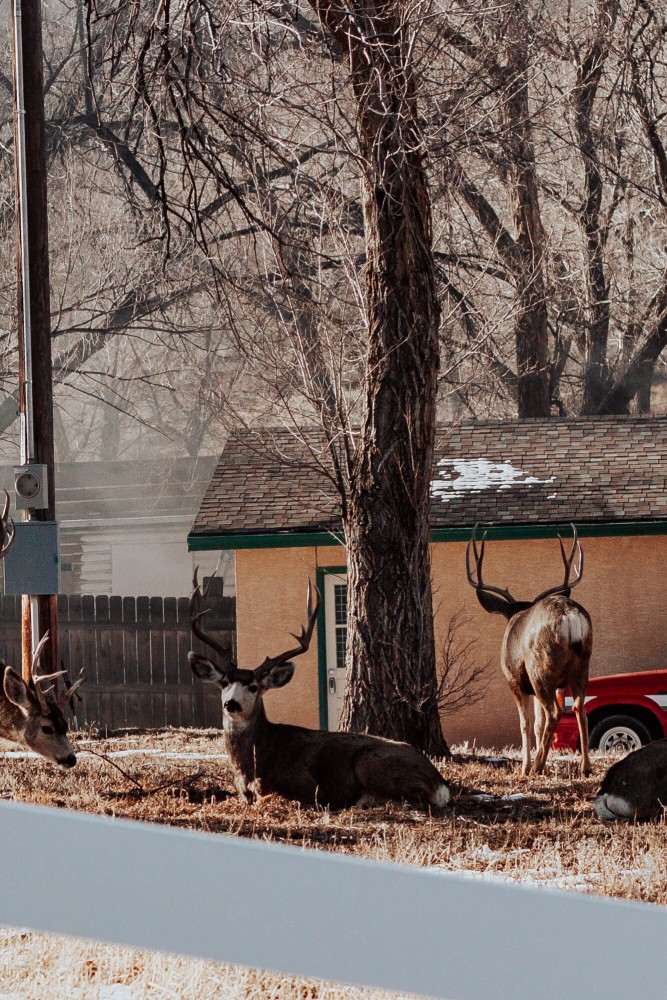
How To Keep Deer Away From Eating Plants And Trees In Your Yard?
As deer can be a real nuisance for gardeners and homeowners, it’s important to keep this wildlife off your property in the first place.
The most effective way to protect trees and garden vegetation from deer is fencing. If there are many trees in your orchard, enclose the whole area using woven-wire fencing. However, to properly deer proof the area, the fence must be a minimum of 6, or even 8 feet high. It also needs to be at an angle of around 30 degrees.
Other methods to keep deer away include mesh netting, choosing deer repellent plants, flowers, and shrubs, as well as using chemical deterrents and scare devices.
If you’re having constant problems with deer and need wildlife removal and control, it’s important to get in touch with a professional as removing deer can be very challenging. Westchester Wildlife company provides humane live and dead deer removal services in Fairfield County CT, or Westchester, Putnam, and Dutchess Counties NY. Call us today for a free phone consultation or appointment.
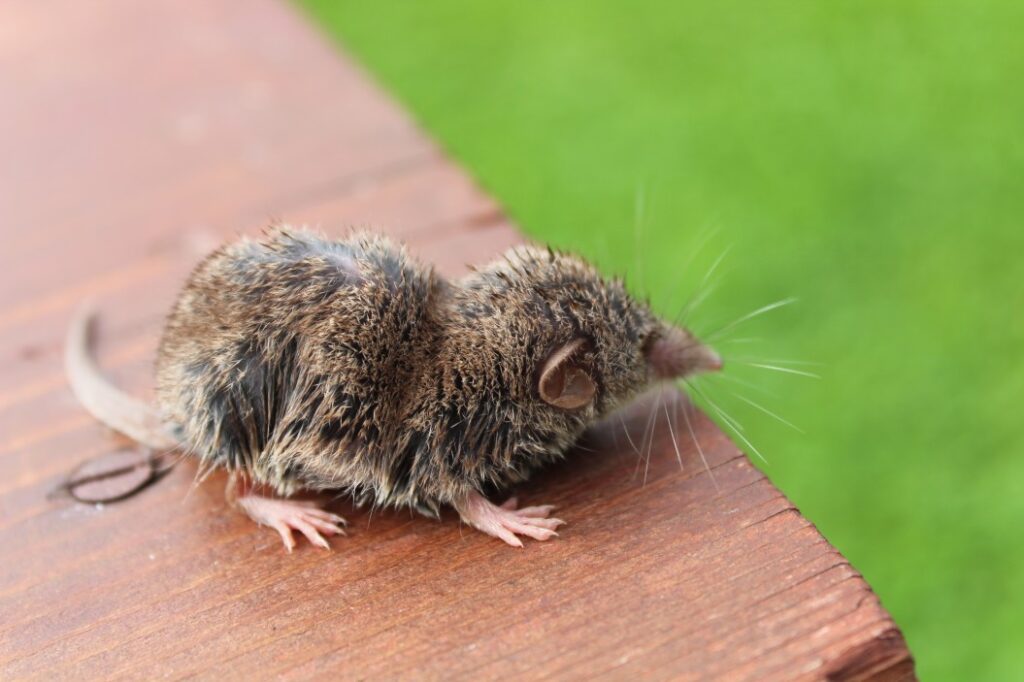 Do Shrews Dig Holes And Live Underground In My Yard?
Do Shrews Dig Holes And Live Underground In My Yard?
The shrew has a long, pointed snout and protruding whiskers. It might look cute but it is a dangerous little animal and an outdoor pest that can be often found digging its way through yards. For its residence, it either builds its burrow from scratch or takes over an abandoned burrow from other rodents like chipmunks or moles.
You might often notice several one-inch-diameter entrance holes are left around the yard by shrews when they dig their underground tunnel systems. In the wild, these holes are most likely found in areas with damp, shaded, overgrown vegetation.
But shrews do not discriminate and they also love to dig holes in gardens and yards. Unfortunately, this causes a lot of damage for homeowners. While these animals are at it, they’ll often uproot entire plants. In addition, their shallow tunnels in lawns can become a safety hazard for people.
Keep reading to learn more about shrews digging and living in your yard.
Do Shrews Dig Tunnels, Burrow, Or Nest Underground?
Shrews are ground animals that live in a great variety of habitats. Most of them prefer locations that are well-covered shelters under the ground so that they can be protected against predators and the harsh winter weather.
The exact habitat depends on the species, but in most cases, shrews make their home in your yard, either underground in abandoned burrows, or by burrowing underneath flat rocks, tree stumps, blocks of pavement, big rotting wood logs, in vegetation like bushes, in tree cavities, and in the crevices of house foundations.
They dig small tunnels that often lead to the entrance opening of the burrow. Because of their location, you can tell them apart from the rest of the holes in the yard. This is also due to the size and angle of the holes, which makes it easier to identify them as the holes dug out by shrews. These mammals can also excavate tiny, dime-sized holes in the lawn in order to gain access to mole tunnels.
Shrews are not as much destructive as moles and voles, thus, many people choose to leave them alone. Foraging for insects, worms, spiders, snails, and grubs in the grass, shrews search for them both above and below the ground.
Unlike other small mammals, shrews do not create surface tunnels. Instead, they prefer to tunnel underground and use the runways and tunnels constructed by larger animals such as voles or moles.
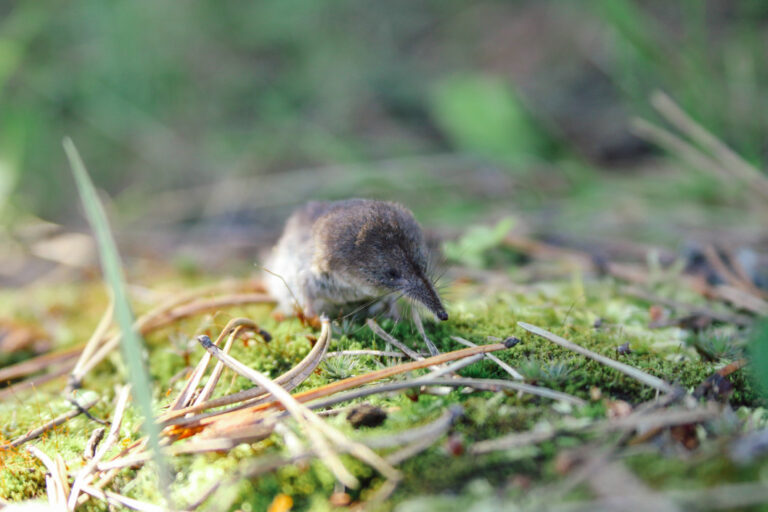
How Deep Can Shrews Dig?
The shrews have strong front feet with 5 clawed toes on each foot, which enables them to dig deep into the ground. They remove the loose soil and dirt from the tunnel with the help of their hind feet by kicking it out, or by pushing it out with their elongated snout.
On average, the burrows are around 4 inches deep below the surface, but in the most extreme cases, as much as 20 inches can be dug into the ground. The burrow is flat inside, both on the bottom and at the top. The nest itself is made inside the burrow and is covered with fur or dense, dry vegetation.
Do Shrews Come Above The Ground?
Similar to mice and rats, shrews are great climbers. They can also jump up for more than 4 inches in the air, which makes them very agile. They need to be constantly on the move, so they come above the ground from time to time, particularly at night, as they are nocturnal animals. You can sometimes notice them running on the ground rapidly with jerky movements.
If not staying in their burrows, shrews can be sometimes found scurrying on the ground, or getting around in runways made in leaves and other surface litter or snow. However, this wildlife spends most of its time underground.
With that said, shrews are not afraid to enter homes searching for food or shelter, even if they prefer to live outdoors.
For the most part, the yard damage caused by shrews consists of underground tunnels and holes they dig in search of food. Shrews are one of the most voracious wildlife that can invade people’s residences, thus, causing a lot of destruction. Having a very high metabolism, they need to feed almost continuously.
Shrews are known for gnawing on tree bark, chewing grass and plant roots in yards. They also contaminate food sources, such as vegetables and fruits in the garden, with their urine and droppings.
Despite that, as they can be easily mistaken for voles, shrews might get all the blame for destroyed yards. But in general, even though they can ruin the look of your lawn with their holes, these mammals are beneficial as they are important members of the ecosystem. They prey on species such as rodents, harmful insects, and other outdoor pests.
However, if the shrews have invaded your property and have become a nuisance, they may need to be eliminated. Call Westchester Wildlife for advice or schedule an appointment with one of our experienced and knowledgeable pest and wildlife professionals.
All in all, the best way to get rid of shrews in the yard is through trapping. But these animals run fast and can easily escape without being caught. If you need help trapping and removing a shrew from your home or yard, get in touch with our team in Westchester, Dutchess, Putnam Counties in NY, or Fairfield County in CT. We will be happy to assist you!
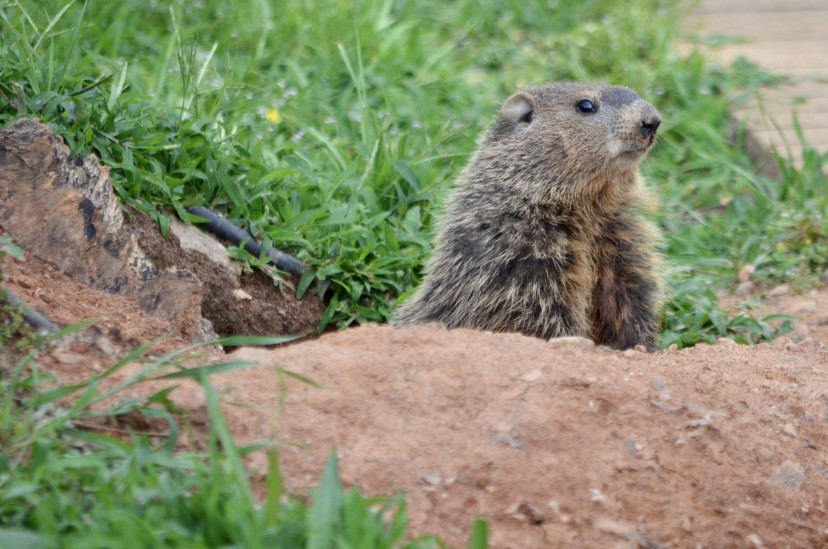 Do Groundhogs Hibernate In Winter?
Do Groundhogs Hibernate In Winter?
You must have heard about the groundhog tradition that originated in Pennsylvania. It suggests that if the groundhog sees its shadow, it will return to its den and you can expect another 6 weeks of winter. However, if the animal does not see its shadow, then spring is just around the corner!
A groundhog is not just like any other wild animal that you see in the woods or might take up residence on your property. It has some fascinating behavior that sets it apart from most wildlife.
According to scientists, the groundhog, also known as the woodchuck, is considered to be a deep hibernator in the wintertime. What it means is that they spend the whole winter in a state of hibernation.
Hibernation is a form of unconscious sleep and a state of lowered metabolism and suppressed appetite which causes the animal not to eat. As the animal does not feel hunger or stress, it can save energy and conserve nutrients for later use. Hibernation helps the animal to survive in the harsh winters when food is scarce.
In fact, the groundhog spends a large portion of the summer and fall season chowing down on the foods that they eat. And, once it builds up all of the fat that it needs on its body, it is ready to get inside its burrow for the hibernation period.
If you want to learn more about some of the unique habits of groundhogs, keep reading!
Why Do Groundhogs Hibernate And How Do They Prepare For Hibernation?
There may be different reasons why some animals hibernate during the winter months.
One of the most common reasons for the groundhog’s hibernation is its dietary needs, especially when food is scarce. Groundhogs have a difficult time finding food sources during the winter season because of the scarcity of the foods that they consume.
Thus, nature causes the groundhogs to go into a deep hibernation state for their survival. This is also why they eat constantly during the off-season (i.e. the summer months) to prepare their body for these long and cold winter months.
The groundhog’s appetite hormones regulate metabolism during the hibernation period and help the body conserve its energy.
As groundhogs burrow in the ground, before going into their winter sleep, they dig a den that comfortably accommodates them. The groundhog sleeps for between 5 and 7 months, but typically, this hibernation period lasts from October to March.
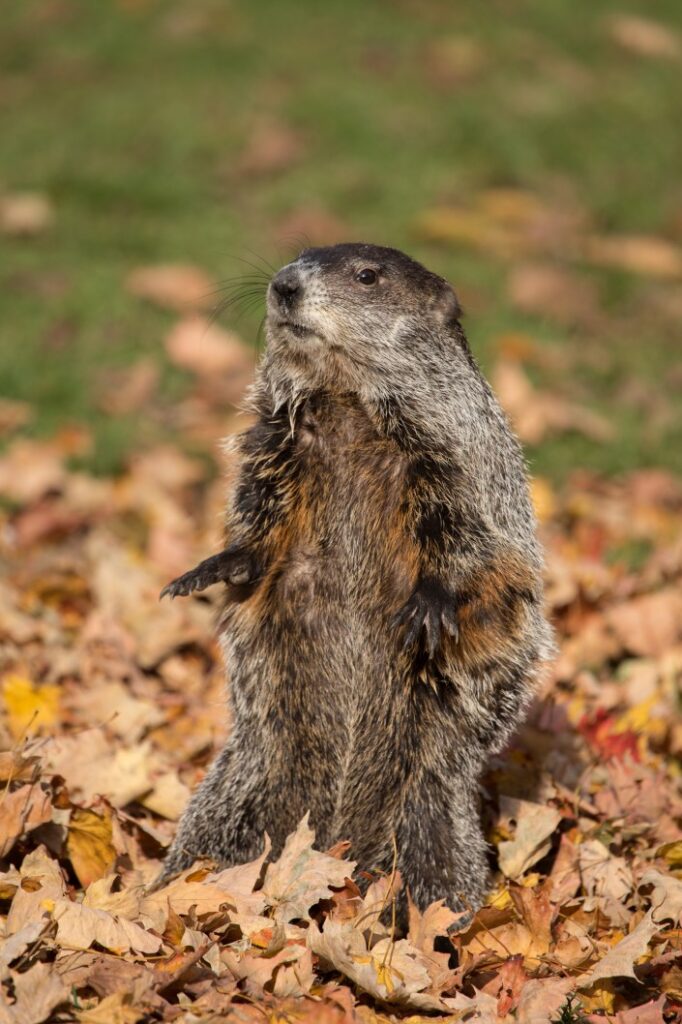
What Happens When Groundhogs Hibernate?
The groundhog’s body lowers all movements and functions to ensure that the animal can survive while sleeping through the winter.
According to the National Wildlife Federation, the temperature of the groundhog’s body will decrease significantly. It will drop from 99° F to about 37° F. This rodent stays warm by conserving body heat, which can help maintain the core body temperature at a stable level.
In addition, there are also other changes that occur in their body when the groundhogs are inactive during the hibernation period. For instance, their heart rate reduces and their breathing will slow down as well. Thus, the rate of their breathing will drop from around 16 breaths to just 2 breaths per minute. Their normal heart rate of about 80 to 100 beats per minute during the pre-hibernation period will reduce to just 4 or 5 beats per minute.
These are the primary reasons why these animals are referred to as deep hibernators.
Where Do Groundhogs Hibernate?
These rodents are solitary creatures and tend to hibernate alone. As mentioned earlier, groundhogs hibernate in underground burrows that they dig using their powerful claws and teeth.
The hole is a circular area covered with leaves, grasses, sticks, and branches. To keep itself warm inside the hole, the animal covers the den with piles of dirt that serve as insulation from the cold.
Do Groundhogs Eat During Hibernation?
Groundhogs don’t wake up to eat during their hibernation period. They are herbivores, which means they only feed on vegetation, and that is not readily available in winter. When in their natural habitat, these animals could therefore be driven into starvation due to the lack of food in the freezing weather. But groundhogs must survive without eating for months at a stretch and avoid starvation.
Thus, they are highly adapted to survive even when such food is scarce in the wintertime. Groundhogs hibernate to conserve energy and prevent hunger. They are able to survive on stored fat and use it to produce energy during hibernation.
They get energy when fat in their body is used. Also, their body has reduced their nutrition needs, allowing the groundhog to survive for a few months without eating.
Do you need groundhog removal services in Fairfield County CT, or Westchester, Putnam, and Dutchess Counties NY? Our professionals at Westchester Wildlife can humanely and safely trap and remove groundhogs that live on your property. So contact us today for a free phone consultation or an appointment.
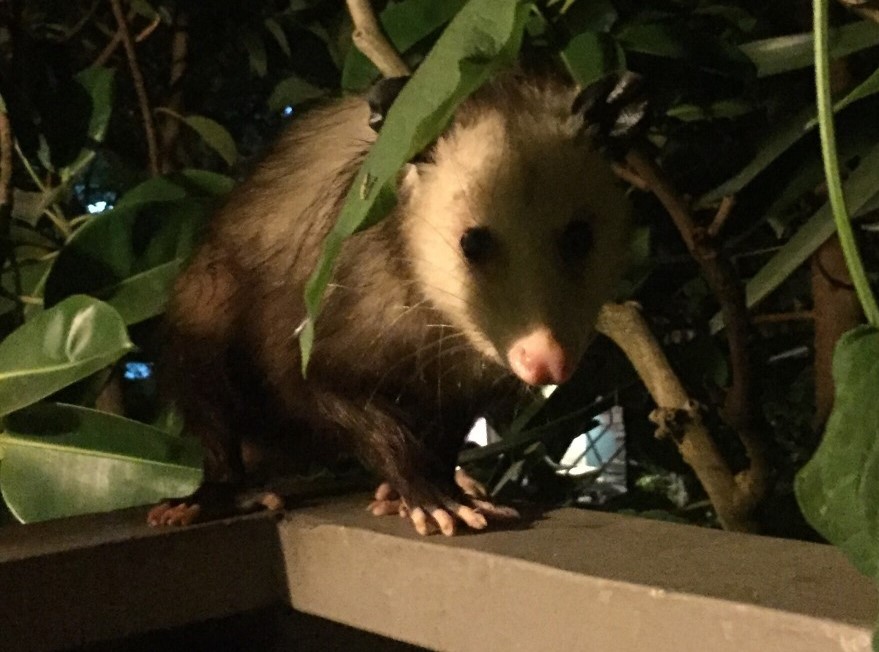 Can Opossums Climb And Get In Your Walls?
Can Opossums Climb And Get In Your Walls?
If you are like most homeowners, you do not like wildlife taking up residence in your house. Perhaps you are wondering whether opossums can climb and get in your walls. If you do not take precautions, the answer is “Yes!”
How High Can Opossums Climb?
Opossums are incredibly agile, they can easily climb a tall vertical wall. They are known to jump from a tree to a roof at a distance of up to 13 feet. This wildlife can use its thumbs, feet, claws, and tails to climb many different surfaces.
When it comes to how high they can actually climb, it is difficult to determine. It all depends on what they can grab onto, and the surface itself.
While an opossum can climb up a vertical wall, it is easier for one to navigate horizontal surfaces. The animal can do even more climbing if there is a tree near your house, or if you have gutters, eaves, or shingles on your house. As they can climb very high, you may find possums are living in your attic.
Can Opossums Live In Your Walls?
Possums prefer attics, porches, or sheds to make a nest, but they can live in your walls, too. Occasionally, they might end up inside walls because they get stuck or just feel comfortable in there. Similar to other pests, this is a concern you should take seriously.
There are some important reasons to make the walls in your home off-limits to possums.
First, consider the breeding habits of possums. Possums can breed throughout much of the year. While male possums mate with multiple females, a female possum can have one or two litters each year. On average, a litter has between 6 and 9 possums, but litters can be even larger.
Second, possums carry diseases. Even if you do not come into direct contact with a possum, this can lead to germs and bacteria in your home. They can also carry fleas, ticks, toxoplasmosis, salmonella, leptospirosis, and other serious health hazards. You certainly do not want them in your house because they can make you and your family ill.
A third reason to not want opossums in your walls is the damage they can cause. If they find themselves stuck somewhere in the house, they may chew through the walls or destroy the air ducts, just to get out. They can tear up the insulation in your walls, and chew on wooden structures. They can also chew on electrical wiring, which is a fire hazard.
Possums can be bothersome anywhere in your home, but you should definitely take action if they are in your walls.
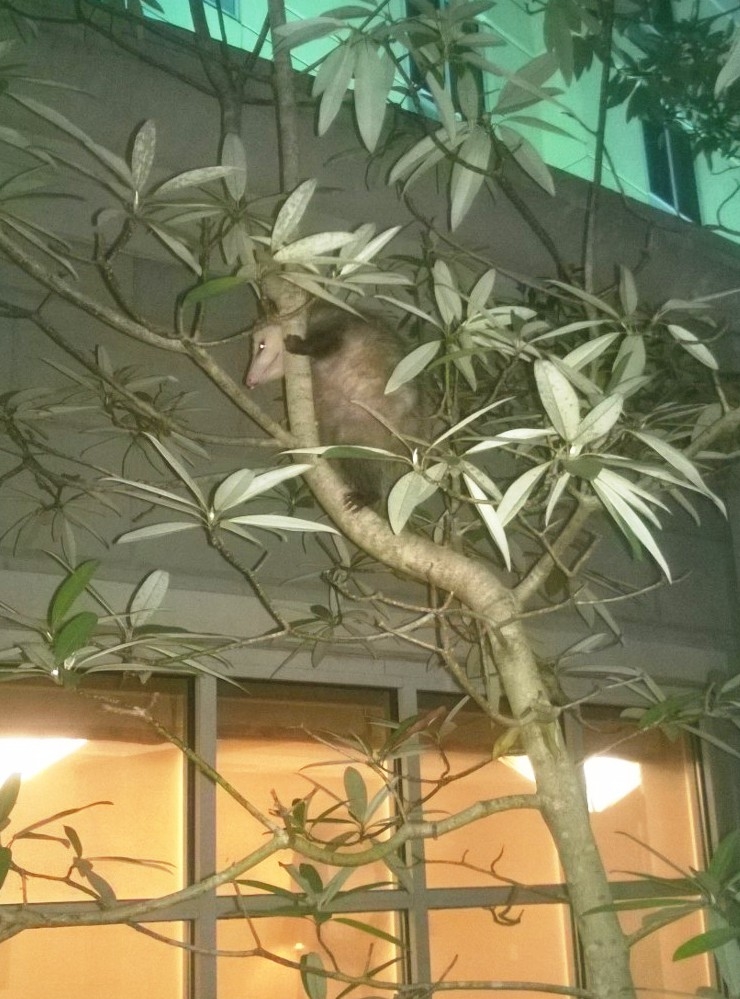
How To Know If There’s A Possum Living In Your Walls?
First, you may hear all kinds of odd noises in your walls, especially during the nighttime. One reason they make noise is they need to search for food. As possums are nocturnal animals, you may hear scraping and shuffling sounds as the animal is moving around in your walls.
You can hear noises when they are nesting, and when a new litter of possums arrives. Excessive scratching noise can indicate a female possum is making a nest. Baby possums make squeaking sounds.
However, the level of activity and the level of noise can both increase if there are multiple adult opossums in the wall. Clicking, hissing, chattering, growling, grunting, and screeching are signs that you are dealing with more than one animal. When male possums want to mate with females, they often make clicking and shook-shook sounds.
Unusual noise is not the only way you can determine the presence of possums in your walls. The second sign of possums is the odor. There are actually a number of different sources. While a possum has its own natural musky odor, the odor from its feces and urine is horrible.
In addition, opossums give off an odor when they are afraid, or fighting. Any strange odor coming from your walls should be investigated.
The third sign of possums is possum poop. The odor is similar to ammonia gas. The feces look similar to dog feces. It is approximately the same size and is usually dark brown. Opossum feces can carry a strain of bacteria that is very dangerous to people.
Fourth, you may see visible signs that opossums are in your house. Perhaps you notice pet food, or your own food, has disappeared. Perhaps your garbage can has been rummaged through or knocked over. Possums generally do not care what they eat. As scavengers, they are as happy with leftovers you put in the trash can as stealing food from your pet’s bowl or a sandwich you did not finish.
There can be other visible signs to the house itself. You may see damage to your home’s exterior or interior. Claw marks, and marks from scraping, scratching, and chewing are clear signs an animal is living in your house, and that animal could be an opossum.
If you suspect a possum is in your house, it is time to investigate. And if you know these animals are present, it is time to get rid of them.
Opossum removal from walls is essential to prevent costly damage to your home. However, larger animals, such as opossums, can prove tricky to exclude. They need to be captured using safe and humane live cage traps.
We are committed to solving your possum problem in the most efficient way possible. So get in touch with the experts at Westchester Wildlife for a free quote or just for some free phone consultation.
 Is It Bad To Have Bats In Your Chimney?
Is It Bad To Have Bats In Your Chimney?






















